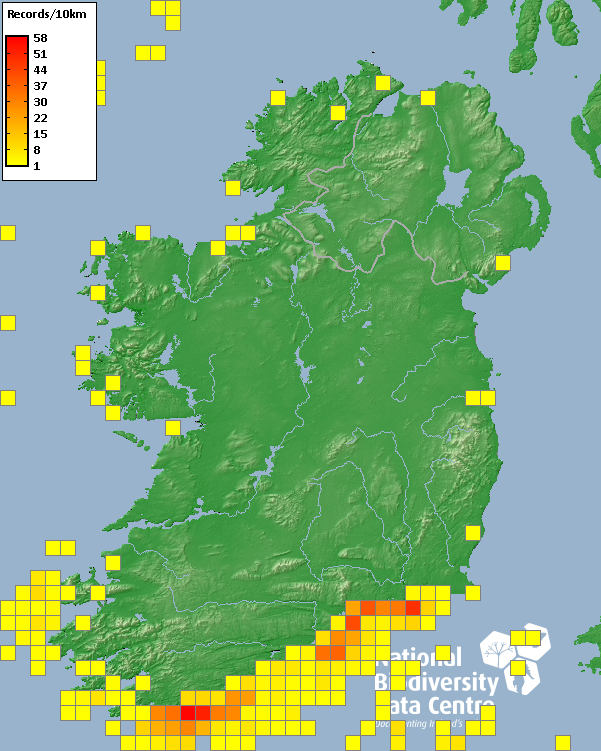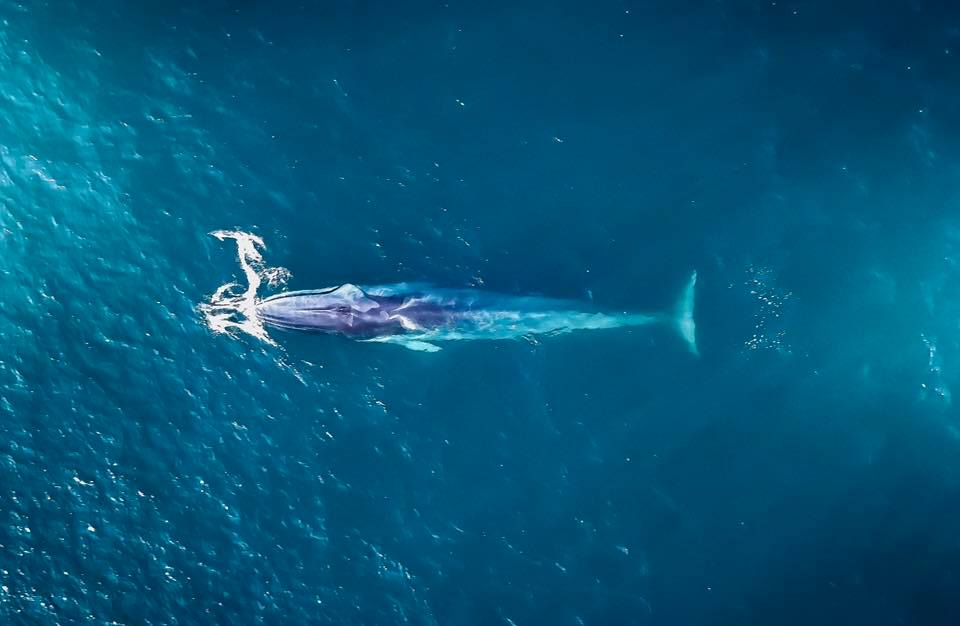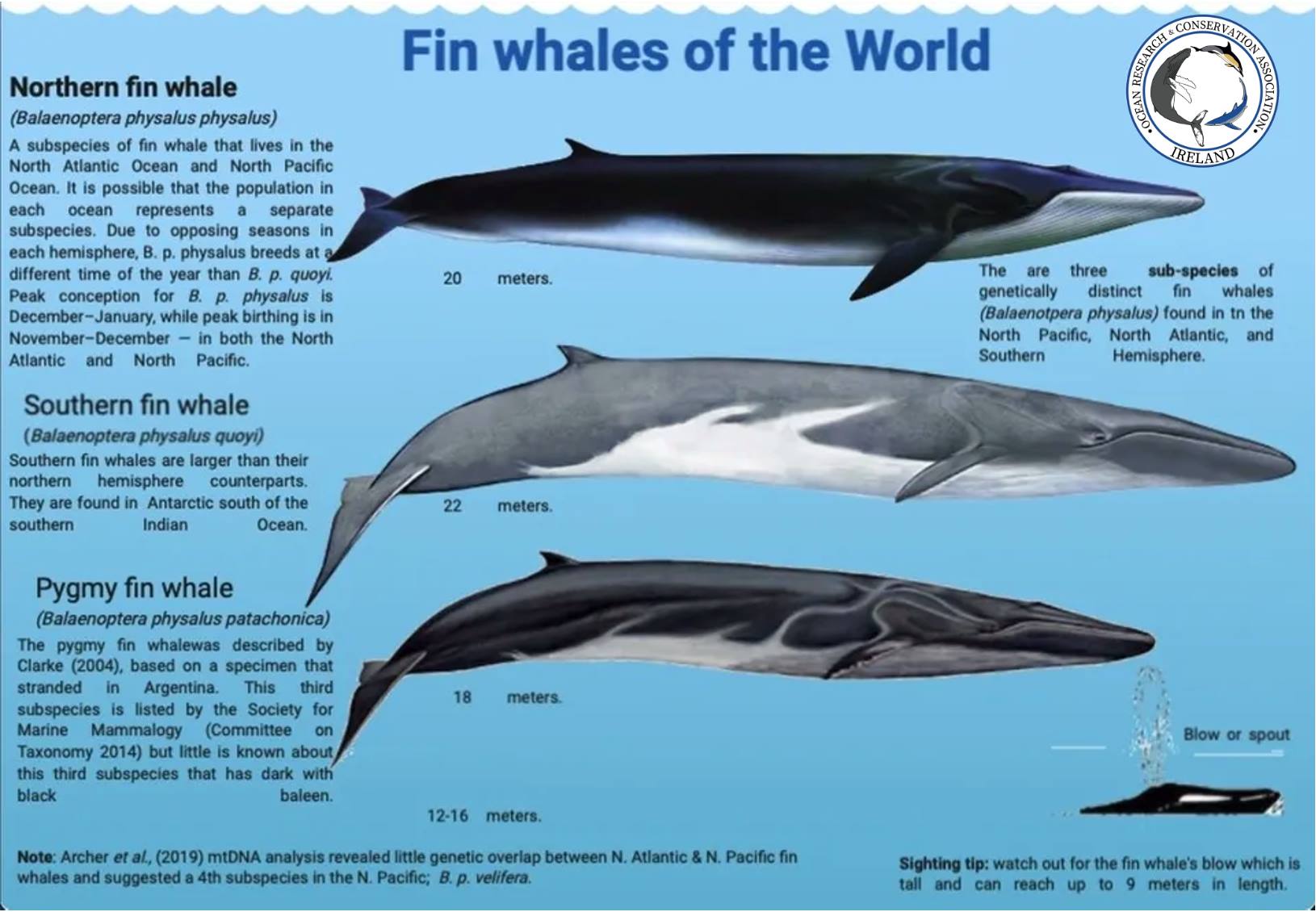Fin whale
(Balaenoptera physalus)
Fin whale aerial photograph captured off the Cork Coast. Source: Greg Coleman/O.R.C.Ireland.
Next Species ----->
<----- Previous Species
Classification:
Kingdom: Animalia
Phylum: Chordata
Class: Mammalia
Order: Artiodactyla
Infraorder: Cetacea
Family: Balaenopteridae
Genus: Balaenoptera
Species: B. physalus
Get the Facts:
The fin whale is the second largest animal on Earth, after the blue whale. It is also known as the finback whale, herring whale, razorback whale or common rorqual. Fin whales belong to the suborder Mysticeti or baleen whales. The fin whale is nicknamed "the greyhound of the sea" as its one of the fastest cetacean species and can sustain speeds of up to 37 km/hr or have burst speeds of up to 46 km/hr.
Species Identification:
The fin whale’s body is long and streamlined. Its back and sides are a dark grey to brownish-black, while the underside of the belly, flippers and tail flukes are white. Between 50 and 100 throat grooves extend from the lower jaw back towards the naval. These grooves allow the throat to expand during feeding. A fin whales baleen (long, flat plates made of fingernail-like material - keratin) can be made up of 280 - 480 baleen plates. The fin whale’s head makes up the first quarter of its body, it is triangular in shape (V-Shaped) and flat on the upper surface. One of the most distinguishing features of a fin whales head is its bottom right jaw which is white. Its dorsal fin is about two-thirds of the way along its back, up to 60cm tall and curves backwards. At the surface fin whales emit a robust blow that sends an inverse cone of spray up to 6 metres (20 feet) into the air. The blow is visible at quite a distance on a calm day.
Similar species: Sei whale and minke whale.
Diet:
Considering their size fin whales consume surprisingly small prey, although in large amounts. The particular prey taken varies according to geographical location and time of year but typically includes small shrimp-like crustaceans (such as krill and other similar species), tiny copepods and other zooplankton, squid and several species of schooling fish including cod, herring and sprat. A fin whale can eat up to 2 tons of food every day, however they fast in the winter while they migrate to warmer waters.
Habitat:
Fin whales are found in deep, offshore waters in all major oceans, primarily in temperate and polar latitudes. They are less common in the tropics. They occur year round in a wide range of locations, but the density of individuals can vary in any one area seasonally. Most fin whales migrate from the Arctic or Antarctic feeding grounds in the summer months to tropical breeding and calving areas in the winter months. Fin whales can be seen offshore and in Irish coastal waters and can sometimes be spotted from coastal promontories especially in the south west of the country.

Behaviour:
Fin whales dive to depths in excess of 200 metres (656 feet) but usually undertake a number of shallow dives, surfacing as many as ten times at 15-20 second intervals before taking a deeper “terminal” dive. This makes even small pods of fin whales quite easy to detect as they generate several explosive blows every minute. Like other baleen whales, fin whales lunge and skim feed, taking in huge volumes of water. When they close their mouths, the water is pushed out through the baleen and the prey is caught and swallowed.
Social Structure:
Outside of the breeding season, a fin whales social structure can vary depending on where in the world they are located. Although they are generally seen individually or in pairs, fin whales can to be encountered in groups of between 3 to 10 animals, and sometimes in larger feeding groups, even from 50 to 300 animals. In the North Atlantic they are often seen feeding in large groups and are often associated with other species such as humpback whales, minke whales and dolphin species, such as short-beaked common dolphin, bottlenose dolphin or Atlantic white-sided dolphin.
Reproduction:
Male fin whales reach sexual maturity at 6- 10 years and females at 7 to 12 years, they reach physical maturity at 25 years of age. A single calf is born every 2 to 3 years after a gestation period of 11- 12 months. In the north east Atlantic calves are born between December and April and are 6 metres long at birth. They are fully weaned at 6-8 months old. A newborn calf can weigh between 2 and 4 tons and be as long as 6 meters.
Vocalisations:
Fin whales produce low frequency vocalisations that are called "20Hz pulses" although they are usually downward sweeps in frequency from about 30 to 15 Hz. Their vocalisations can be as loud as 184- 186 underwater dB, making them one of the most powerful biological sounds in the ocean. Scientists can use these loud sounds to study fin whale distribution, as fin whales have been shown to have feeding and breeding calls, although these are only produced by male whales, which serve as breeding displays - attracting females from great distances to concentrations of prey that the males have found.
Lifespan:
Fin whales live to around 90 years of age and have few natural predators, although there are records of adults being attacked by hunting groups of killer whales.
Fin whales of the world: There are three official subspecies of fin whale in the world; the Northern fin whale (B. physalus physalus) in the North Atlantic and North Pacific, the Southern fin whale (B.physalus quoyi) in the Southern Ocean and the pygmy fin whale (B.physalus patachonica) in the mid latitude Southern Ocean. In 2019, a study examining mitochondrial DNA (mtDNA) suggested little overlap between N. Atlantic and N. Pacific fin whales and suggested a fourth subspecies in the North Pacific (B. p. verlifera).
Global Distribution:
Fin whales are native to the following countries or territories: Algeria; Angola; Antarctica; Argentina; Australia; Belgium; Bermuda; Bouvet Island; Brazil; Canada; Cape Verde; Chile; China; Congo; Congo, The Democratic Republic of the; Croatia; Cyprus; Denmark; Ecuador; Falkland Islands (Malvinas); Faroe Islands; Fiji; France; French Southern Territories (Kerguelen); Gabon; Germany; Gibraltar; Greece; Greenland; Heard Island and McDonald Islands; Iceland; Indonesia; Iran, Islamic Republic of; Iraq; Ireland; Isle of Man; Israel; Italy; Japan; Korea, Democratic People's Republic of; Korea, Republic of; Lebanon; Libya; Madagascar; Malaysia; Malta; Mauritius (Rodrigues); Mexico; Monaco; Morocco; Mozambique; Namibia;Netherlands; New Caledonia; New Zealand; Norway; Pakistan; Peru; Philippines; Portugal; Réunion; Russian Federation; Saint Helena, Ascension and Tristan da Cunha (Tristan da Cunha); Saint Pierre and Miquelon; Saudi Arabia; Seychelles (Aldabra); Slovenia;South Africa; South Georgia and the South Sandwich Islands; Spain; Sri Lanka; Sweden; Syrian Arab Republic; Tunisia; Turkey; United Arab Emirates; United Kingdom; Republic of Ireland and the United States. There may be resident groups of fin whales in some areas such as the Gulf of California, the East China Sea and the Mediterranean Sea. Fin whale migration routes are complex and specific routes have not been documented, although data from passive acoustic monitoring suggests a southward "flow-pattern" in the autumn from the Labrador-Newfoundland area, past Bermuda and into the West Indies.
Population Status:
It is estimated that there is a global population status of 100,000 individual adult fin whales around the world and their populations are recovering post whaling era. Commercial whaling
severely depleted fin whale numbers in both the northern and southern hemisphere, and they were still hunted commercially in some areas until as recently as the 1980s. The north Atlantic fin whale population today is thought to consist of between 35,000 and 50,000 animals.Fin whales are listed as
Vulnerable
according to the IUCN Red List.
Threats to Survival:
Threats to the survival of fin whales include vessel strike, entanglement in fishing gear and noise pollution. Accidental vessel strikes can kill or injure fin whales. The projected increases in ship traffic arising from the opening of trans-polar shipping routes, as Arctic sea ice continues to decline will subsequently increase the risk of vessel strike and ambient noise and pollution.
Fin whales can also become entangled in fishing gear, either swimming off with the gear attached or becoming anchored. Many different types of fishing gear threaten whales, including traps, pots and gillnets. Once entangled, whales may swim and drag the attached gear over vast distances, ultimately resulting in fatigue, compromised feeding ability or severe injury which may lead to reduced reproductive success and death.
Ocean noise can interrupt fin whales normal behaviour, mask their vocalisations and move them out of important habitats for feeding and reproducing. Exposure to intense underwater noise pollution can lead to strandings.







